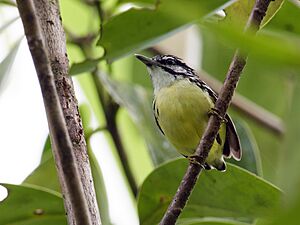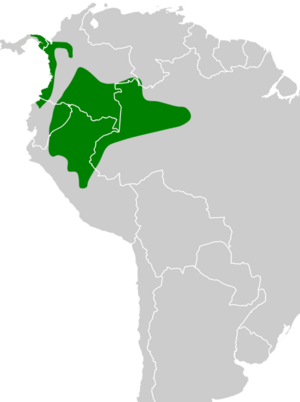Moustached antwren facts for kids
Quick facts for kids Moustached antwren |
|
|---|---|
 |
|
| Conservation status | |
| Scientific classification | |
| Genus: |
Myrmotherula
|
| Species: |
ignota
|
 |
|
The moustached antwren (Myrmotherula ignota) is a tiny bird found in the warm, wet forests of Central and South America. It lives in countries like Brazil, Colombia, Ecuador, Panama, and Peru. This small bird is part of a group called "typical antbirds." They are known for living in forests and often eating insects.
Contents
What's in a Name?
The moustached antwren has two main types, called subspecies. These are M. i. ignota and M. i. obscura. Scientists first thought M. i. ignota was a type of pygmy antwren. Later, some thought it was its own species, calling it "Griscom's antwren." The other type, M. i. obscura, was once called the "short-billed antwren."
In 2003, scientists decided that these two types were actually part of the same species. They combined them under the name "moustached antwren." The name Myrmotherula ignota was chosen because it was the first name given to one of the types.
What Does It Look Like?
The moustached antwren is a very small bird, only about 7.5 to 8 centimeters (about 3 inches) long. It has a very short tail.
Male moustached antwrens have a wide black "moustache" mark on their face. They also have a black stripe through their eye and white cheeks. Their head, back, and tail are black with thin white stripes. These stripes look a little yellow. They also have a white patch between their shoulders. Their wings are black with white tips and edges. Their belly is yellow with a few black stripes.
Female moustached antwrens look a bit different. They have buff or light brown stripes on their head. They do not have the white patch on their shoulders. The females of the M. i. obscura type have a more buff-colored head, throat, and chest than the other type.
Where Does It Live?
The moustached antwren lives in different areas that are not connected. The M. i. ignota type is found in Panama and parts of western Colombia and northwestern Ecuador. The M. i. obscura type lives further south. It is found in south-central and southeastern Colombia, eastern Ecuador, northeastern Peru, and parts of western Brazil.
These birds mostly live high up in the trees of lowland evergreen forests. These are forests where trees stay green all year. The M. i. ignota type can also be found in older secondary forests. These are forests that have grown back after being cut down. In the Amazon, the M. i. obscura type lives in both high ground forests and floodplains.
They especially like the edges of forests, areas where trees have fallen, and along rivers. You can find them at different heights depending on the country. In Panama, they can be found up to 1,100 meters (about 3,600 feet) high. In Colombia, they are found up to 1,000 meters (about 3,300 feet). In other places, they usually stay below 600 meters (about 2,000 feet).
Behavior and Habits
Movement
Scientists believe that the moustached antwren stays in the same area all year long. It does not migrate to other places.
What Does It Eat?
The moustached antwren eats small creatures like insects and spiders. It usually looks for food alone, in pairs, or with its family. Sometimes, it joins groups of different bird species that are all looking for food together.
It searches for food in the middle and upper parts of the forest, usually between 10 and 40 meters (about 33 to 130 feet) high. It actively checks thin branches, vines, leaves, and moss for prey. Sometimes, it will fly briefly from a branch to catch an insect in the air.
Reproduction and Life Cycle
Not much is known about how moustached antwrens raise their young. One nest found in Peru was like a small pouch. It was made of lichen and spiderwebs. The nest was hanging from a fork in thin branches. Both parent birds were seen building this nest in August.
How Does It Sound?
The moustached antwren's song is a fast series of short notes. These notes get higher and louder, then lower and softer. Its call is a short, uneven whistle that goes down in pitch. The M. i. obscura type also makes a sudden, sharp note.
Conservation Status
The IUCN (International Union for Conservation of Nature) has listed the moustached antwren as a species of "Least Concern." This means it is not currently in danger of disappearing. It lives across a very large area.
While its exact population size is unknown, scientists believe the number of these birds might be slowly decreasing. However, no major threats have been found right now. The moustached antwren is considered uncommon to fairly common in the places it lives. It can also be found in several protected areas.
Even though much of its home has not been disturbed by people yet, there are some future worries. More oil exploration and new roads in eastern Ecuador, along with a highway in Panama and Colombia, could pose threats to its habitat.


